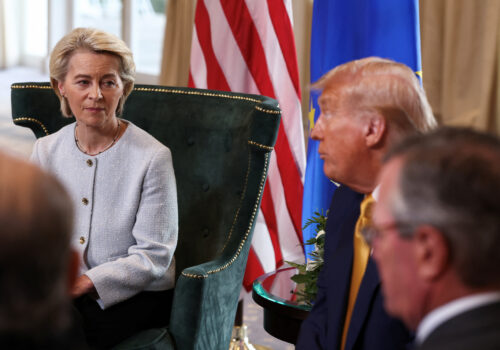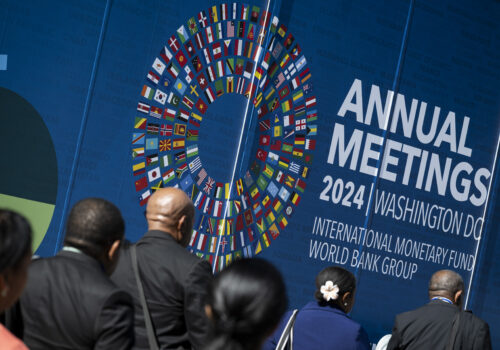For emerging markets, the biggest threat isn’t reduced aid. It’s financial volatility
Foreign aid flows from the United States Agency for International Development (USAID) to emerging markets totaled more than forty billion dollars in fiscal year 2023, a sum often portrayed as a lifeline for growth and stability, and one that has drawn intense attention since the agency’s official shutdown on July 1. But here’s what has gotten almost no attention: the $3.5 trillion in commercial sovereign debt of emerging markets that can be destabilized overnight as global financial uncertainty increases. In recent months, emerging markets’ sovereign and corporate bonds have been under constant strain, largely driven by erratic fiscal and trade policy signals in the United States.
While the halting of foreign aid is a serious mid- and long-term discussion, the disruption caused by rapid capital outflows and market freezes is far more acute. Financial shocks destabilize national budgets in real time and spark broader economic and political crises. Consequently, they create potential entry points for corrosive capital, financing that lacks transparency and accountability. At a time when globally imported risk in emerging markets is tied to the rise of corrosive capital, the United States can play an important role as a responsible and tranquilizing international actor.
Three channels of transmission
To understand how financial shocks travel across borders and deepen emerging-market vulnerabilities, it is crucial to unpack the mechanisms through which instability in the US financial system transmits abroad. Below are three channels that, although presented distinctively, often overlap as countries are exposed to multiple shocks at once:
The risk channel
Periods of heightened uncertainty or adverse news from the United States can prompt investors to “de-risk.” As emerging market assets are generally considered riskier, this causes a capital flight toward safer options, such as US Treasuries, gold, and AAA-rated bonds. For example, in the days following the April 2025 tariff shock, major emerging market exchange-traded funds, which are baskets of assets, experienced sharp outflows and price drops; only as global sentiment stabilized in May did inflows resume. This abrupt reallocation lifts emerging markets’ yields and spreads, sometimes within days, and can abruptly tighten credit availability even for fundamentally sound emerging economies.
The dollar channel
The sovereign and private debt of emerging markets’ economies is often denominated in US dollars. Data for emerging markets consistently show that the stock of liabilities denominated in US dollars is greater than the stock of US dollar assets they hold. This means that emerging markets are “net short” on the dollar. By extension, a US dollar appreciation will lead to a higher net appreciation in the liabilities than the assets, creating a gap. That the dollar has been rapidly devalued in recent months amid fiscal uncertainty is still troubling, as it could leave emerging markets exposed to an upward reversal.
The liquidity channel
Broader shifts in global liquidity driven by the US Federal Reserve or US banking stress can tighten credit everywhere, even in places with no direct link to the original problem. Liquidity shortages are rapidly transmitted shocks that impact all borrowers at once and are difficult to insulate against. Whereas countries can defend against risk channel-transmitted shocks (by providing credible signals) and their dollar-channel equivalents (by diversifying debt), there is no insulation against a global liquidity crunch.
The connection to corrosive capital
Financial volatility can create financing vacuums quickly filled by authoritarian or opaque lenders. A critical entry point for corrosive capital is nonmarket mechanisms such as resource-backed loans, currency-swap lines, and emergency deposits, which become lucrative only after the wells of transparent markets dry up. Between 2004 and 2018, a survey of resource-backed loans found that interest rates, collateral clauses, and repayment schedules were publicly available in only nineteen out of fifty-two cases. Respectively, currency-swap lines usually force closer bilateral trade cooperation with the issuer due to limited currency convertibility, while emergency deposits are often collateralized with strategic assets and increase dependency on authoritarian lenders. In short, corrosive capital flourishes where constructive capital deems investments as too risky, and this can become self-reinforcing.
Amidst the COVID-19 pandemic, Sri Lanka, a frequent issuer of dollar-denominated sovereign bonds, sought support from China, including a one billion dollar swap line from the People’s Bank of China that provided strategic leverage over the country. An appreciation in the dollar, along with heightened global risk, led to an over 50 percent decrease in the value of the country’s bonds in just three months. This resulted in increased yields, locking the country out of the international market.
A similar case of the dollar channel at play was Pakistan in 2022, where foreign exchange reserves dwindled and debt increased following US dollar appreciation, leading to higher borrowing costs. This opened the way for a new four-billion-dollar rollover of commercial loans and deposits from Chinese state banks. The loan was poorly negotiated, had unclear and unfavorable terms, and constituted part of the wider leverage of China over Pakistan through previous China-Pakistan Economic Corridor loans.
In the same year, in Ghana, sovereign Eurobond yields spiked above 20 percent, which made external commercial borrowing unsustainable. Instability was primarily transmitted through the risk channel. Investors rapidly sold off Ghanaian bonds, reflecting a broader “flight to safety,” with capital moving to assets such as US Treasuries, pushing the sovereign’s yields to unsustainable levels. With spreads at such levels and no appetite from private markets, Ghana turned to China for emergency financing. This resulted in a two-billion-dollar barter deal, in which Ghana exchanged future bauxite revenues for infrastructure investments by Chinese state-owned SinoHydro.
In April 2025, Angola hit the news when dollar bonds tumbled, triggering a $200 million margin call that pushed yields near 15 percent, effectively shutting it out of global capital markets. Importantly, the mechanism at work here was the liquidity channel. It was not a reduction of Angola’s creditworthiness, nor dollar appreciation, but a broader shrinkage in the willingness to extend dollar credit globally that drove yields up. Although no subsequent entry of corrosive capital has occurred to date, Angola is already highly indebted to China, with a lot of its debt collateralized against future oil revenues.
The role of the United States
It’s not a coincidence that these countries engaged with corrosive capital only after their monetary and fiscal capacity deteriorated. In contrast to market mechanisms, which are symmetrical agreements between equal partners, corrosive capital is by its nature asymmetrical. It capitalizes on the extraordinary circumstances that make it lucrative in the first place. High yields, irrelevant of their domestic or international origin, pave the way for its entrance.
In this environment, the United States should act as a responsible internationally stabilizing agent. Financial stability is a nonrival and nonexcludable global public good, forming the backbone of today’s globalized world. The United States had historically helped “grow the pie” by offering the certainty that tamed inflation expectations, reduced risk, and minimized market frictions globally. This has helped bridge global financiers with emerging markets, benefiting both alike.
As political freedom continues to decline for the twelfth consecutive year worldwide, global risk and trade policy uncertainty are high. For the United States, a recommitment to free trade, prudent fiscal policies, and the promotion of an environment conducive to business are the mandatory steps toward defending freedom, prosperity, and its interests. Domestic shocks will always exist, even more so in emerging markets, but a stable global economy can provide a cushion, crowding out corrosive capital through market-oriented constructive capital.
Achilles Tsirgis is a visiting fellow at the Atlantic Council’s Freedom and Prosperity Center.
Further reading
Mon, Jun 23, 2025
2025 Freedom and Prosperity Indexes: How political freedom drives growth
Report By Ignacio Campomanes, Nina Dannaoui-Johnson, Annie (Yu-Lin) Lee, Joseph Lemoine
As the Freedom and Prosperity Indexes show political freedom declining worldwide for the twelfth straight year, new data analysis shows its importance for lasting prosperity: Though authoritarians promise economic rewards, democratizing countries gain an 8.8 percent GDP per capita boost over twenty years than their autocratic peers. With democracy on the ropes, what else can the Indexes tell us?
Sun, Jul 27, 2025
How big a deal is the new US-EU trade announcement?
Fast Thinking By
Our experts unpack the framework for a trade deal announced by US President Donald Trump and European Commission President Ursula von der Leyen on Sunday in Scotland.
Wed, Nov 6, 2024
Rethinking international economic cooperation for the twenty-first century
New Atlanticist By Rabah Arezki
In the twenty-first century, the challenge is to rebuild international economic governance in a world increasingly organized around geopolitical blocs.
Image: Charts moving up and down. Charts moving up and down. Stock market and exchange, volatility, opportunity, investment, trading. REUTERS



